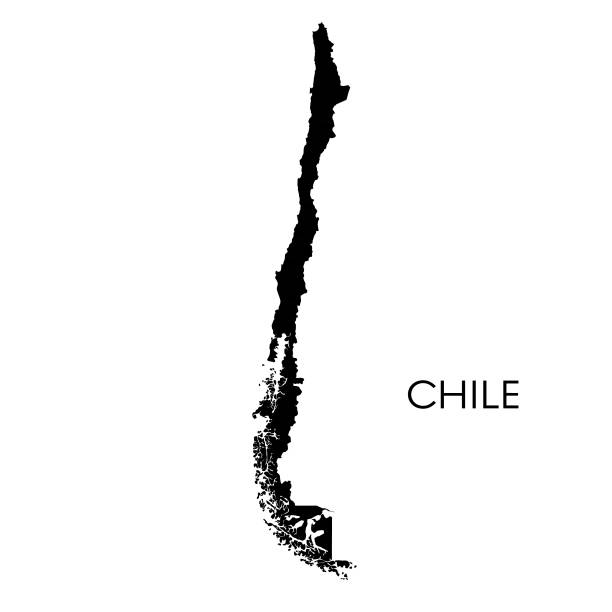Recently, some family members picked up on the "New York Times" online puzzles that include Wordle and the deceptive Worldle. The Worldle puzzle tricks the puzzler into thinking they know more about world geography than they do. Worldle shows the outline of a country like Italy or Chile and the puzzler is then asked to guess the country.
Anyone knowing even the basics of geography easily recognizes Italy's boot shape. But what about trying to guess the many small African countries, or Chile?
Chile should be easy. Long and slender, it runs north to south for nearly 4,300 miles along the western coast of South America. The widest part of Chile is a mere 49 miles, between the snow capped Andes mountains in the east and the Pacific Ocean Pacific Ocean in the west.

That doesn't leave much room for wine growing. Yet, the Chileans have skillfully found the best spots for vineyards, at high altitudes in the northern region of Salta, and the flatter southern expanses of Bio-Bio.
Standing on the coast, facing east, the Andes seem to be hiding behind the near horizon of a rising landscape. But the mountains are there forming a barrier, keeping phylloxera, an aphid that has destroyed many vineyards elsewhere and continues to be a problem, from entering Chile. On the plus side, the year round mountain snow fields in the Andes are a continuous source of runoff, supplying water to Chile's extensive system of irrigation canals.
For years, Chilean grape growers used the ample Andes runoff to irrigate their vineyards. In the past, grapes were once sold on weight, so growers would flood their vineyards just before harvest, plumping the berries. Stories are told of the resistance from older growers to the introduction of drip irrigation and the efforts to control vineyard flooding.
The Regions & Wines
Here's a breakout of Chile's top wine regions, north to south:
Aconcagua is the northernmost fine wine region, known mainly for red wines like Cabernet Sauvignon and Merlot. Vina Errazuriz pioneered much of the grape growing in Panquehue and Manzanar sub regions. Errazuriz's Don Maximiano Bordeaux-style blend is one of Chile's best-known red wines. Chardonnay, Sauvignon Blanc and a little Pinoir Noir from the cooler coastal Manzanar are among Aconcagua's most successful wines.
Close to the coast, south of the major port city of Valparaiso, the small region of Casablanca is noted for the bulk of Chile's cool-climate wines such as Chardonnay, Sauvignon Blanc and Pinot Noir. South of Casablanca, the San Antonio valley is one of Chile's newest wine regions, with the same cool-climate varieties as Casablanca.
An aside. Casablanca and San Antonio valleys are both coastal regions growing the same cool-climate grapes. Where they differ is that the San Antonio valley runs north to south with all vineyards benefiting from the cool coastal breezes, while Casablanca runs east to west which means it is a transversal valley with warmer zones in the east and cooler zones in the west closer to the ocean.
Another anomaly for those of us living in the Northern Hemisphere is remembering that in the Southern Hemisphere, the further south you go, the cooler it becomes, while a warmer more tropical climate is in the north.
Beyond the smaller northern zones, most of Chile's wine comes from the Central Valley, a huge area, including the capital city Santiago, stretching north to south from Maipo to the Southern region zones of Bil-Bio and Itata.
Directly east of San Antonio valley is Maipo, the most famous wine region in Chile. Maipo vineyards have a predominance of red varieties like Cabernet Sauvignon, Merlot and Carmenere. Whites are Chardonnay and Sauvignon Blanc. Top wineries: Concha y' Toro, Carmen, Santa Rita, Cousino Macul, Patrick Valette.
Rapel is divided into two transversal valleys: Cachapoal and Colchagua, that run from the Pacific Ocean to the Andes. Cabernet Sauvignon, Merlot and Carmenere are the most planted varieties. The potential of Rapel for great wine has attracted foreign investment: Los Vascos (Ch. Lafite-Rothschild)and Casa Lapostolle. Other wineries: Vina Montes, Undurraga, Santa Emiliana.
Curico has two sub-regions of note: Lontue and Teno. Little was known of Curico outside Chile until 1979 and the arrival of Spanish vintner, Miguel Torres. Except for Torres, the other Curico wineries of note are Valdivieso and San Pedro, although all the big wineries have extensive vineyards in Curico.
Maule, one of Chile's cooler regions, has five sub-regions, with Talca and Linares the most important. Many of Maule's western vineyard areas are deficient in nutrients, especially nitrogen, but modern vineyard practices are helping to overcome these problems. Once an area for bulk wine, Maule now grows varieties like Cabernet Sauvignon and Carignan.
In the Southern region are two relatively new wine regions: Itata and Bio-Bio. Lacking the protection of the Andes, the southern regions experience higher rainfall and cooler temperatures. Cinsault and Muscat of Alexandria are the most planted varieties by Concha y' To William Fevre.
 |
| Alto Bio-Bio |
Grapes & Vines
Until the 1990s, the most common grape variety in Chile was the Pais, but in a short time, Cabernet Sauvignon shot into first place as the most planted variety, followed by Sauvignon Blanc, Merlot, Chardonnay and Pinot Noir, the latter a slow performer in Chile.
One interesting aspect of Chile's vineyard leap forward in the early 1990s was the discovery that much of what was thought as Sauvignon Blanc was, in fact, Sauvignon Vert and Sauvignon Gris. And DNA vine identification also showed that a lot of Merlot was Carmenere.
The bright side is that innovative Chilean marketers turned this confusion around, making Carmenere the Chilean signature wine, the way that Argentina captured Malbec.
Today, Chilean wines are among the world's finest, especially for high quality for the price.
Next entry: France Series: Loire & Rhone
Contact me at boydvino707@gmail.com
No comments:
Post a Comment
Note: Only a member of this blog may post a comment.